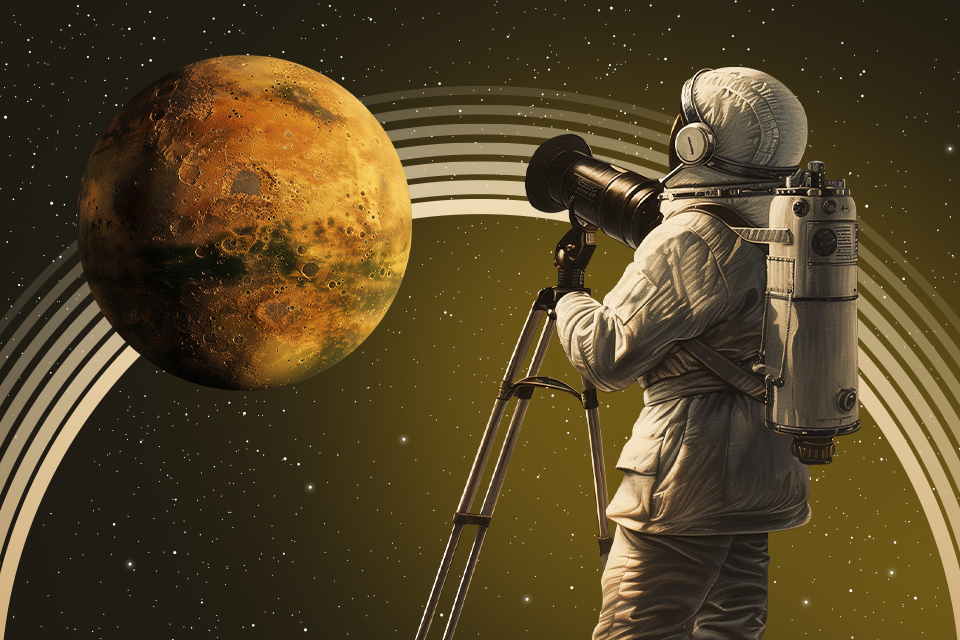On 18 May, Ukraine celebrates Science Day. Astronomy is perhaps the oldest of all sciences, but it still continues to solve the mysteries of the Universe. On the occasion of the holiday, we’d like to tell you how science finds answers to questions that concern not only scientists.

1. Is there life on Mars?
The fourth planet from the Sun, Mars, is very similar to the Earth, and something unusual has been repeatedly observed on it, interpreted as traces of extraterrestrial life, or even an alien civilisation. However, upon closer inspection, all of these things turned out to be natural formations. And the spacecraft orbiting this celestial body for several decades have not found any evidence of the presence of any organisms.
However, all this does not mean that there has never been life on the Red Planet. Substances that may be the result of the activity of living beings have been repeatedly found in samples of meteorites that came from there. Numerous studies confirm that billions of years ago, Mars was much warmer, wetter and had a hydrosphere in which life could have existed. Now, everyone is waiting for samples of clay rocks from those times to be brought back to Earth to find out for sure.
As for the possibility of life on Mars today, scientists have not yet ruled it out. If there are hot thermal waters somewhere under the Martian surface, they may well be home to a hitherto unknown ecosystem.
2. What do scientists think about the ninth planet in the Solar System?
Ever since Pluto was reclassified from a regular planet to a dwarf planet in 2006, scientists have been looking for some new hitherto unknown large body. However, no suitable candidate has been found yet.
Moreover, studies conducted by the WISE infrared satellite have shown that no Jupiter-sized or even Neptune-sized body exists in the vicinity of the Sun at a distance of hundreds of AU. And this space telescope sees tiny brown dwarfs at distances measured in light-years.
However, some groups of astronomers continue to look for evidence that we are actually missing something. The main evidence of this is the orbits of some objects far from the Sun, which are allegedly under the gravitational influence of an unknown body. However, other scientists point out that the data presented are “stretched by the ears”.
3. Are there any Earth-like planets?
Over the past three decades, scientists have discovered several thousand planets near other stars, and even more are in the status of unconfirmed candidates. So science knows for sure that the solar system itself is not unique. The existence of the Earth’s “twin” is another matter.
For this to happen, the celestial body must not only have a mass and radius similar to our planet, but also move in such an orbit that the amount of energy it receives from its star is commensurate with what the Earth receives from the Sun.
Over the years, scientists have discovered not many Earth-sized planets. Most of the discovered bodies are still much more massive and closer to their stars.
We already know about planets similar in size to the Earth. Some of them even receive energy comparable to that of the Earth. However, the habitability of each of them raises some questions.
4. Where are intermediate-mass black holes hidden?
Ordinary people consider black holes to be one of the most important mysteries of the Universe. In their minds, this is something that science still does not understand. In fact, objects that have an event horizon and are formed as a result of supernova explosions are not so mysterious.
Scientists are much more concerned about why they have found black holes with masses 3-20 times greater than the Sun and those that are millions of times heavier, but there is virtually no evidence of anything in between.
Why we don’t see hundreds or thousands of intermediate-mass black holes is a real mystery to scientists, because such objects should be an intermediate link connecting the results of supernova explosions with their supermassive relatives that exist in the centres of galaxies. Perhaps they simply do not interact with anything, or perhaps they simply do not exist, which means that there are certain gaps in our understanding of the evolution of the Universe.
5. Was the Big Bang really the beginning of the Universe?
The Big Bang theory suggests that approximately 13.7 billion years ago, the entire Universe was gathered into one point and then rapidly expanded. Scientists made this conclusion many decades ago based on an analysis of the speed of galaxies. The further away they are from us, the more their light shifts to the red region of the spectrum, which means that they are flying away from us faster.
This movement is caused by the expansion of the Universe, and scientists use the redshift to determine the date of its beginning. In addition, theoretical models predict other phenomena that have already been observed, such as the existence of background radiation at different wavelengths.
Nevertheless, there are still sceptics who propose alternative scenarios. For example, some argue that over billions of years, a photon can “age”, losing energy, and the red shift is explained by this, not by the expansion of the Universe. However, the Big Bang theory is the best explanation for all observed phenomena.

